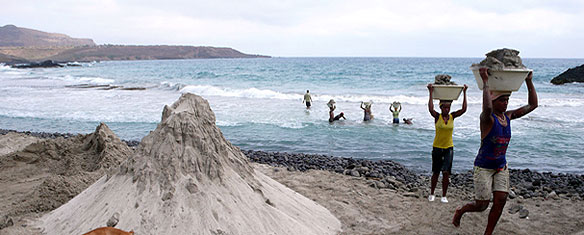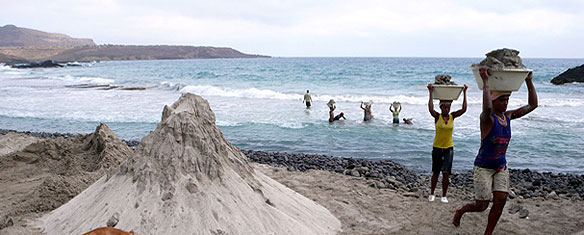Les Voleuses de Sable, Video
By Aurélia Michon and Régis Michel, France 3 Thalassa.
The Women Sand Thieves
Translated from french original:
There is a small strip of land left to the whims of the Ocean.
450 km off the west coast of Africa, close to Mauritania and Senegal, with rocky mountains, lush valleys and sandy beaches, Cap Verde 10-islands archipelago appears as a small corner of paradise lost in the middle of the Atlantic Ocean.
And yet, these rocky islands have few resources to offer to the local inhabitants. Most raw materials are imported… except beach sand.
On the beaches, they are thieves, almost exclusively women, who collect sand, to be sold to the slow yet ever expanding construction industry.
Every day, hundreds of women scrape, shovel, dig, sift and hoard beach sand by the tons. The task is grueling, worsened by the scorching sun.
Once the shore is depleted, the women, tossed by waves and burnt by sea salt, sink and dredge relentlessly, even further into the sea.
The looting is so extensive that many beaches in Santiago, the main land, have virtually disappeared—all that remains is gravel. The disappearing beach takes on the appearance of open-pit mine. The ecological consequences are disastrous. The sea salt washed onshore by the surf ends up inland, and destroys crops and plantations.
The Cape Verdean government banned the extraction of sand in 2002, calling the latter a prime necessity. At Pedra Badejo, the great black sand beach is protected by the military to prevent its disappearance.
But the options are few and in a country where unemployment is high, sand has become, in too many cases, the sole and illegal source of income for women in the archipelago.
Meanwhile, young girls are pulled away from school, as early as 12 years old (as depicted in the above documentary) and brought to the shores, most of them crying at first, then docile, ultimately resigned to a strenuous and unsustainable life of sand stealing…

Les Voleuses de Sable, French Original Version
Il existe une petite bande de terre abandonnée aux caprices de l’océan. Entre reliefs escarpés, vallées luxuriantes et plages de rêve, le Cap Vert est un petit coin de paradis perdu au milieu de l’atlantique.
Et pourtant ces îles rocailleuses n’ont pas beaucoup de richesses à offrir à leurs habitants. La plupart des matières premières sont importées, sauf le sable. Du sable qui est devenu l’unique source de revenus pour les femmes de l’archipel. Elles le revendent à l’industrie du bâtiment, en pleine expansion.
Chaque jour, elles sont des centaines à gratter, retourner, tamiser les plages. Et quand il n’y a plus de sable, elles s’enfoncent encore plus loin… dans la mer.
Les conséquences écologiques sont désastreuses. Sur Santiago, l’île principale, le pillage est quotidien. Les plages disparaissent et le sel remonte à l’intérieur des terres, décimant les plantations.
Le gouvernement capverdien a interdit l’extraction de sable, qualifiant ce dernier de bien de première nécessité.
Mais les solutions sont rares et dans un pays où le taux de chômage est fort, les femmes n’ont de toute façon pas d’autre choix que d’être des voleuses de sable.









